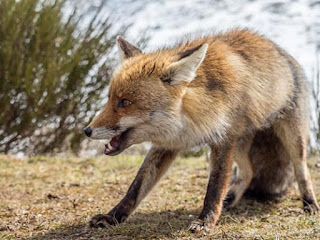 |
| Rabid fox |
First, because it’s such a unique story, as well as one marking a historical
133rd anniversary, there’s
the woman in Pittsgrove Twp. who strangled a rabid fox attacking her. Unable to
escape the animal -- by then “gnawing sideways on her [already] wounded leg” --
or reach garden tools usually at hand, she “grabbed its snout with her left hand
holding it tightly shut. With her right
hand she grabbed the fox’s neck and squeezed” . . . The animal “soon went limp.”
The July 26 Times of Trenton
story about this gutsy woman (treated at a local hospital before starting two weeks
of rabies treatment) ended with a count of NJ rabies cases so far this year (72
terrestrial -- 49 raccoons, 13 skunks, 9 cats, 1 groundhog -- and 9 rabid bats)
and familiar advice: if you are bitten,
seek medical care immediately.
In July 1885, Louis Pasteur successfully tested his new rabies
vaccine on a nine-year old boy who had been bitten by a rabid dog. Joseph Meister would probably have died without
the vaccine, but he recovered and was declared in good health a few months
later.
A death row ‘shelter’ for animals?
 |
| Michael Mancuso pic |
Since earlier this month, heated charges
and counter-charges have been exchanged over Hamilton Township’s animal
shelter. The main issue was the “kill
rate” for animals at the facility, which with much fanfare was renovated to
increase capacity (and budget and staff) in 2015. Nonetheless, since then, the euthanasia rate
has barely dropped.
Why has the kill rate remained
high? What euthanasia policies (and practices) are in place? When is euthanasia
deemed necessary there -- for feral/community cats? for unclaimed animals? for
those needing medical care? for all of the above?
What do Hamilton taxpaying
residents know of what goes on at their shelter? Are they aware that the facility’s “kill rate”
numbers have been higher than at other area shelters (with even more animals
impounded) since at least 2014? And that
the facility’s supervisor is reportedly against “Trap-Neuter-Return,” widely
regarded as the most humane and cost-effective way to manage cat populations?
Is this brouhaha over animals killed really nothing more than a “political stunt,” as the mayor claims? Has she correctly described shelter employees as
“our compassionate animal shelter staff”? Or are they, as others describe them, “killers
of innocent animals”?
We wish we could
hear from the animals at Hamilton Township’s shelter, but of course we can’t. As
usually happens in such circumstances, those “innocent animals” are caught in
the middle. We can hope only that the
investigation underway is thorough and efficient, with full disclosure of
findings.
Sea-world mother love
Mother elephants
come to their babies’ rescue when they’re in danger. Cat, dog, horse and duck mamas often seek humans’
attention when their babies have fallen down wells or been trapped in myriad
other ways.
The animal world is
full of happy-ending stories, all illustrating
the maternal bond of animal moms and their offspring. In its continuing coverage of animal life, The Dodo (https://www.thedodo.com)
often publishes these heartwarmers.
But there are terribly
sad situations out there too. A current
story includes photos of a grieving orca (killer whale) mother who has carried her dead calf
on her head for days. It’s as if she can’t
accept the fact that he died shortly after his birth. So, for longer than such shows of feeling have
usually lasted, she has kept her baby with her.
Does it get any sadder than that? Could there be better proof of animal feelings
that are so like our own?
#
















